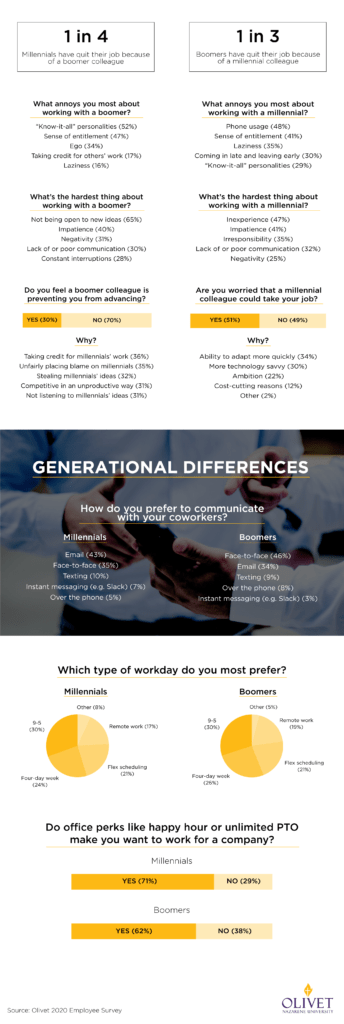More than a third or 39% of baby boomers say they plan to leave their job within the next six months. The number is exactly at a third or 33% for millennials.
The data comes from the Olivet 2020 Employee Survey, which looked to find out just how these two demographics feel about each other. And of course, this is in part brought on by the catchphrase ‘OK Boomer.’
Generational differences aside, businesses have to accommodate both groups in order to succeed. And as older employees stay longer in the workforce, companies have to find ways to bring them together for the common goal. Surveys like this one can help businesses gain insight into what each group is thinking and implement policies to make it work.
Generations in the Workplace Statistics
Here are some takeaways from the survey.
There is very little difference in how they feel about money, career, working environment and passion for work.
When asked about leaving their job in the next six months, the difference was only 6%. With 39% of boomers opting to leave, while 33% of millennials said the same.
As to why they are leaving, the reasons are pretty much the same. Millennials are leaving to advance their career 28% (boomers 30%); escape a toxic work environment (millennials 20%, boomers 27%); find a passion for work (millennials 11%, boomers 9%).
Money
The biggest difference in the survey between both groups is money. When hiring baby boomers — or millennials — keep these differences in mind. While 38% of millennials say they will leave their job to make more money, it goes down to 29% for boomers. And when it comes to actually leaving their job for more money, again millennials (84%) are willing to leave compared to 75% of boomers.
A deeper look into the satisfaction of their current pay reveals boomers are happier than their counterparts. Only 53% of millennials are satisfied with their pay compared to 71% of boomers. But millennials are also asking for a raise in fewer numbers (39%) compared to boomers (51%).
This also extends to their hesitation when it comes to asking for a raise. But in this case, it is almost the same with 58% of millennials and 59% of boomers stating they are hesitant.
Preferences
The ability to communicate effectively in businesses is absolutely essential. And considering all of the available tools in the marketplace, finding solutions everyone can agree on is key.
The biggest difference between the generations is in face-to-face communications. Forty-six percent of boomers prefer to see the coworkers they are talking to in person, but it goes down to 35% for millennials. Conversely, 43% of millennials prefer email, while 34% of boomers like emails.
The preference in the type of workday only saw a two-percentage difference with remote work, flex scheduling, four-day week and 9 to 5 schedule for both groups.
Admiration and Annoyance
Both sides have some positive traits they admire about each other. Boomers say their millennial coworkers are positive (34%), problem solvers (32%) and accountable (24%). For their part, millennials say boomers are dependable (42%), punctual (41%) and have the ability to have a keen eye for detail (26%).
The annoyance they feel about each other has been responsible for millennials and boomers quitting their job. Millennials say the know it all personalities (52%), sense of entitlement (47%) and egos (34%) of boomers is what annoys them most about their older coworkers.
Boomers didn’t hold back. They say smartphone use (48%), sense of entitlement (41%) and laziness (35%) gets under their skin about millennials.

Working Through Differences
The workplace covers different groups of employees. Even though some industries have more parity, there are still differences. Do you want to learn more about managing millennials in the workplace?
Bringing them together and making it work is not easy. But with the right combination of young, old, male and female employees, a business can take advantage of their abilities to be an innovative company.
The Survey
From Feb. 28 through March 13, 2020, 1,005 millennials between the ages of 24 to 39 and 1,025 baby boomers between the ages of 56 to 74 were surveyed. The respondents for millennials were made up of equal parts male and female, and for baby boomers, it was 51% female and 49% males.
The participants are full-time workers across a range of industries.
Image: Olivet
